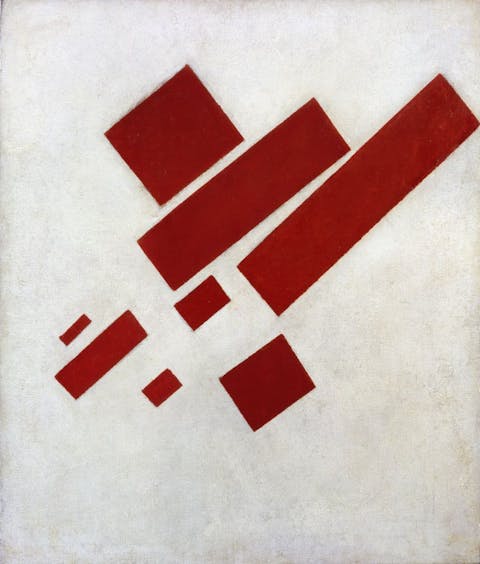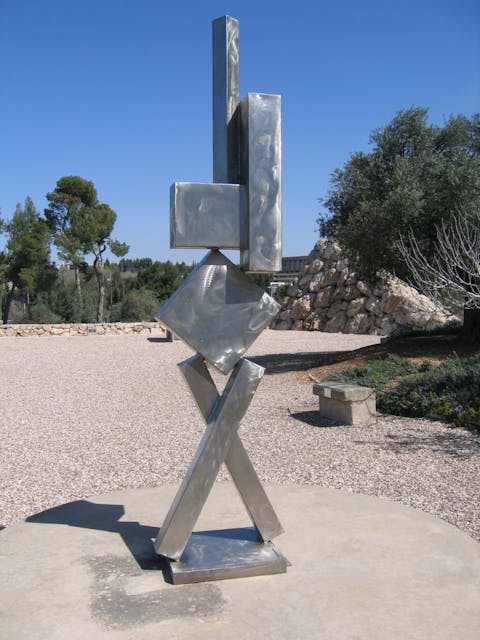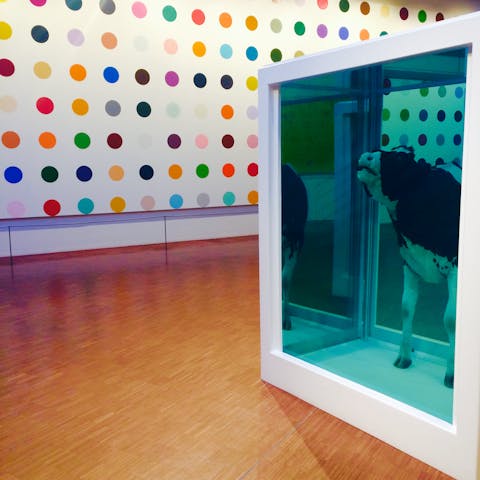Expert's Guide: Contemporary Art
Written by Patrick Morgan
When collecting Contemporary Art, the field is vast, without limits, and offers endless possibilities. But in defining Contemporary Art, the parameters are complex and ever-changing.
What is Contemporary Art?
The basic definition of Contemporary Art is "a work created by a living artist". However, this doesn't include the multitude of media, influences, and historical timelines that compose these complex works, which sometimes defy description.
Contemporary Art challenges the viewer, asking, "can you understand what has been laid before you?". Much like a poem, each work tries to convey a specific message which is often not readily apparent. The confusion between the words Modern and Contemporary is understandable; essentially, they mean the same thing, but in the timeline of artistic movements, these are clearly two separately defined periods.
Do you own Contemporary Art? Follow these easy steps to appraise your Art!

Kazimir Malevich's "Suprematism". (Public Domain)
The History of Contemporary Art
The Modern Art movement began the day Claude Monet presented his iconic work “Impression Soleil Levant” during a Paris Salon Painting exhibition in 1874. A group of like-minded painters, including Edgar Degas and Camille Pissarro, also presented works painted in experimental and unorthodox manners.
This new artistic style would later be deemed by the general public as “The Impressionist Movement”, and would also mark the birth of the Modern Art Period spanning roughly one hundred years from 1874 through the 1970’s.
It was during this evolution of artistic collaborations that artists began to experiment with movement, vibrant colors, and by drawing inspiration from one another as well as from outside influences such as primitive art, and begin to define art in ways never seen before.
What is the Difference Between Modern Art and Contemporary Art
The end of Modern Art defines the beginning of Contemporary Art. In the 1970s, New York was at the center of the transition from Modern to Contemporary Art and was led by the likes of Andy Warhol and Roy Lichtenstein with their “Pop Art” creations.
Pop Art was a commentary on consumerism and the banalities of life. It sought to elevate and juxtapose simple, everyday objects into the context of thought-provoking works of art while drawing on the past artistic movements from the beginning of the 20th century by creating a theme of social commentary and poetic interpretation, which is still strong today. Contemporary Art comprises several sub-categories that are ever-evolving, compelling, and, most of all, surprising.

Vincent van Gogh's "Road with Cypress and Star" – a masterpiece within the Modern Art category. (Public Domain)
Various Types of Contemporary Art Forms
– Photography
– Film
– Music
– Painting
– Sculpture
– Theatrical
– Architectural
– Conceptual
– Digital
But, the field is ever evolving, and new ideas in presentation are always possible. These categories will undoubtedly expand with the progression of Contemporary Art in years to come, which is why this is such an exciting category of Art to collect.

A sculpture by David Smith, one of the most influential American sculptors of the 20th century. (Public Domain)
The Duct-Taped Banana
Contemporary Art has something for everyone. Whether it be a photograph, painting, video clip installation, or a duct-taped banana on a wall... At the Miami Beach edition of Art Basel in 2019, a banana duct-taped on a wall made headlines since it sold for $120,000! The work was made by the Italian visual artist Maurizio Cattelan.

An illustration of Maurizio Cattelan’s “Duct-Taped Banana on a Wall”. (Art Pal)
The Most Important Shows For Contemporary Art in 2023/2024
– Art Basel, Basel, Switzerland
– Art Basel, Miami Beach, USA
– Art Basel, Hong Kong, China
– Art Basel, Paris, France
– Art Paris, Paris, France
– Enter Art Fair, Copenhagen, Denmark
– Frieze, New York, USA
– The Armory Show, New York, USA
– BRAFA, Brussels, Belgium
Appraise your Contemporary Art here!

Visitors at a Contemporary Art fair. (Public Domain)
Major Artists of the Contemporary Art Movement
Banksy
A living London-based street artist, known for his provocative stencils painted on public walls and his astute social commentary, is one of today's major stars, and nobody knows exactly who he is… He's been tagging buildings since the 1990s around the world, and most often, his works revolve around war, love, conflict, economic and or human suffering. On October 5, 2018, Sotheby's London sold a 2008 Banksy painting titled "Girl with a Balloon" for over $1.3 million.
Immediately after the hammer fell at auction, the canvas began sliding out of the bottom of the frame (which had been covertly transformed into a shredder) and was sliced to bits as the work jammed halfway through the shredder. The piece was aptly renamed "Love is in the Bin" and is now considered one of the world's first "intervention/transformational artworks". It was again offered for sale in its "reborn state" with Sotheby's London on October 14, 2021, and sold for a staggering $23.5 million.

A photo of Banksy's street art in Brick Lane, East End, 2004, Matt Whitby. (Public Domain)
Jean-Michel Basquiat (1960-1988)
One of the most instantly recognizable artists from the early contemporary art movement is Jean-Michel Basquiat. His style was graffiti-oriented, and he began by selling miniature postcard paintings for $5 each in Downtown New York restaurants.
His works are childlike and at times disturbing, but always fascinating. Basquiat's first commercial painting sold in a NYC gallery for $200, and was titled “Cadillac Moon”, it was famously purchased by Debbie Harry from the alternative band Blondie.
Soon after this, Basquiat’s popularity soared, and he began working with Andy Warhol, Keith Haring, and a number of other important artists of the period. In 2017, at a Sotheby’s New York Postwar and Contemporary Evening Sale, Basquiat became the most expensive American-born Artist ever sold at auction, with an untitled work selling for over $110.5 million.
Damien Hirst (1965-)
Another groundbreaking Contemporary artist is the British Damien Hirst. Based in London, Hirst is known for diamond-encrusted skulls and paintings with colorful circles, but his most iconic work was commissioned by important gallery owner Charles Satchi in 1991 titled “The Physical Impossibility of Death in the Mind of Someone Living”, by encasing a Tiger Shark in a glass case while immersed in formaldehyde. It was a commentary on the absurd nature of the art world and what people consider a genuine work of art. In 2007, Sotheby’s sold the work for over $12 million.

The Damien Hirst Room at Arken Museum of Modern Art in Denmark. (Arken Museum of Modern Art)
Artist Ai Weiwei (1957-)
Certainly the most well-known living Chinese Contemporary artist today, and his relationship with the Chinese government is contentious. Weiwei is renowned for his outspoken views on communist society, freedom of speech, and China's record of human rights violations. Through his works in sculpture, film, ceramics, photography, painting, and several other media, Weiwei tends to evoke the awareness of present-day China while offering solutions to age-old historical problems. The Chinese government actually classifies some of Ai Weiwei's artworks as a "threat to society". His performance works are provocative, and his large-scale installations can be thought-provoking.
Top 5 Highest Prices Ever Paid For Contemporary Art
1. Willem de Kooning’s “Interchange” (1955)
Sold for $300 million in 2015 through a private sale between the music producer David Geffen, who sold it to the hedge fund manager Kenneth Griffen.
2. Jackson Pollock’s “Number 17A” (1948)
Sold for $200 million in 2015 through a private sale, also between David Geffen and Kenneth Griffen.
3. Mark Rothko’s “No. 6(Violet, Green and Red)” (1951)
Sold for $186 million through a private sale between the Swiss art dealer Yves Bouvier and Russian oligarch Dmitry Rybolovlev.
4. Roy Lichtenstein’s “Masterpiece” (1962)
Sold for $165 million through a private sale between the American philanthropist Agnes Gund to the hedge fund manager Steve Cohen.
5. Francis Bacon’s “Three Studies of Lucien Freud” (1969)
Sold for $142 million by Christie’s New York to Elaine Wynn, ex-wife of businessman Steve Wynn.

A photo of Banksy's street art in Bristol's underground scene. (Public Domain)
How To Appraise Contemporary Art
Whether you're working with a reputable dealer or considering a purchase at auction, the team of experts at Value My Stuff is an excellent source of help. You simply send a few photos of the painting as well as add all the information you know, and within 24 or 48 hours, you get the appraisal certification. For appraisals of all kinds of collectibles, including Contemporary Art, press on this link.
Patrick Morgan is a general certified antique appraiser with over 25 years of experience, working with Caldwell and Associates, based in San Diego, CA, since 1998. Based in Paris since 2002, Patrick visits the auction rooms and combs the flea markets for treasures whenever he has spare time, collecting anything from watches to weapons while continuing his primary focus on Tribal Arts.

